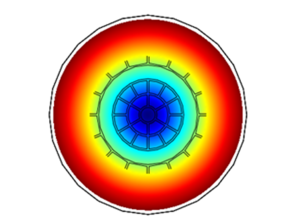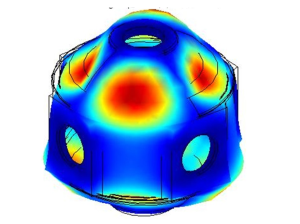Piezoelectric materials are a special class of materials that provide unique behavior associated with mechanical and electric responses. Their crystalline structure is such that charge separation between the positive and negative ions establishes an electric dipole. Groups of dipoles are initially randomly oriented in the raw piezoelectric material, but can be aligned using a poling treatment. After poling the electric dipoles align and roughly stay in alignment thus leaving a remnant polarization. As a result, there is a distortion that causes expansion in the direction of the electric field and a contraction along the axes normal to the electric field.

In the direct piezoelectric effect mechanical energy is converted into electrical energy, allowing piezoelectric materials to be used in applications such as sensors, energy harvesting and strain gauges. Alternatively, with the inverse piezoelectric effect application of an electrical voltage causes changes in dimension, allowing piezoelectric materials to be used as actuators for loudspeakers or to align laser mirrors, to generate focused ultrasound signals and eject ink from printer cartridges.
Because of the anisotropic nature of piezoelectric materials the coefficients that characterize the material’s response are directionally dependent, components made from multiple layers of individual piezoelectric materials cannot be described by these parameters. In addition to Young’s modulus describing the elastic material behavior and the relative dielectric coefficients or permittivity, piezoelectric materials are characterized by several coefficients:
- dij: Strain coefficients [m/V]:
- Strain developed (m/m) per electric field applied (V/m) or due to the sensor / actuator properties of Piezo material
- Charge output coefficients [C/N]:
- Charge density developed (C/m²) per given stress (N/m²).
- gij: Voltage coefficients or field output coefficients [Vm/N]:
- Open circuit electric field developed (V/m) per applied mechanical stress (N/m²)
or strain developed (m/m) per applied charge density (C/m²)
- Open circuit electric field developed (V/m) per applied mechanical stress (N/m²)
- kij: Coupling coefficients [Dimensionless]:
- The coefficients are energy ratios describing the conversion from mechanical to electrical energy or vice versa. k² is the ratio of energy stored (mechanical or electrical) to energy (mechanical or electrical) applied.
The piezoelectric material’s constitutive equation defines how the piezoelectric material’s stress (T), strain (S), charge-density displacement (D), and electric field (E) interact. In Strain-Charge form the piezoelectric constitutive law is:
These relationships apply only to small electrical and mechanical amplitudes and in this range, the relationships between mechanical, elastic deformation S or stress T and electrical field E or electrical flux density D are linear and the values for the coefficients are constant.



To discuss computational modeling of piezoelectric materials with us, please call or complete our contact us form.

